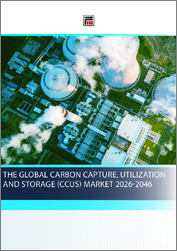
|
시장보고서
상품코드
1776763
세계의 탄소 포집 및 저장 시장 예측(-2032년) : 유형별, 서비스별, 발생원별, 기술별, 최종사용자별, 지역별 분석Carbon Capture and Storage Market Forecasts to 2032 - Global Analysis By Type, Service (Capture, Transportation and Utilization ), Source, Technology, End User and By Geography |
||||||
Stratistics MRC에 따르면 세계의 탄소 포집 및 저장(CCS) 시장은 2025년 39억 달러를 차지하고 예측 기간 중 CAGR 9.6%로 성장해 2032년까지 74억 달러에 이를 전망입니다.
탄소 포집 및 저장(CCS)은 산업원이나 발전소로부터 배출되는 이산화탄소를 대기 중에 방출하기 전에 회수하는 기후 완화 기술입니다. 이산화탄소는 압축되어 종종 파이프라인으로 운반되며 고갈된 유전과 염수대 수층과 같은 깊은 지층에 안전하게 저장됩니다. 이 과정은 온실가스 배출을 줄이고 각 부문의 탈탄소화를 촉진합니다. CCS는 특히 시멘트 및 철강과 같은 배출 감소가 어려운 산업에서 넷 제로 목표로의 전환에 필수적인 솔루션으로 인식되고 있습니다.
Nature Energy지의 기사에 따르면 탄소 포집 및 저류(CCS) 기술은 발전소나 산업자원에서 배출되는 CO2의 최대 90-95%를 제거할 수 있다고 합니다. 같은 연구에 따르면 지중 저류 사이트는 회수된 CO2를 최소한의 누출 위험으로 수천년 동안 안전하게 저류할 수 있다고 합니다.
석유증진회수법(EOR) 수요 증가
성숙한 유전으로부터의 생산량을 극대화할 필요성 증가가 특히 EOR 용도에서의 CCS 기술의 채용에 박차를 가하고 있습니다. 회수된 CO2를 고갈된 유층에 주입함으로써, 석유의 추출 효율을 향상시키는 동시에 대기로의 배출을 삭감할 수 있습니다. 이 두 가지 이점은 석유 및 가스 회사로부터 큰 투자를 끌고 있습니다. 또한 정부의 인센티브 및 탄소 신용 제도는 EOR 전략에 CCS를 통합하도록 산업계에 촉구하고 있습니다.
종합적 인프라 부족
관심이 높아짐에도 불구하고, CCS 시장은 CO2의 회수, 운송 및 저장을 위한 인프라가 개발되지 않았기 때문에 장애물에 직면하고 있습니다. 많은 지역은 적절한 저장 장소에 가깝지 않기 때문에 물류가 복잡해지고 비용이 증가하고 있습니다.
배출 감소가 어려운 섹터의 탈탄소화
시멘트, 철강, 화학 등의 산업은 CO2 배출량이 가장 많아 이산화탄소 배출량 감소의 압력이 높아지고 있습니다. 세계의 넷 제로 목표가 강화되는 가운데, CCS는 산업계의 탈탄소화의 요점으로 지지를 모으고 있습니다.
대체 탈탄소 기술과의 경쟁
직접 공기 회수, 그린 수소, 재생에너지에 의한 전기 등의 새로운 기술은 자금과 정책 지원을 둘러싸고 CCS와 경쟁하고 있습니다. 또한, 이해관계자 중 일부는 CCS를 장기적인 해결책이 아니라 과도적인 해결책으로 간주하며, 이는 투자의 신뢰성에 영향을 미칠 수 있습니다.
COVID-19의 영향:
COVID-19의 유행으로 인해 공급망 중단, 노동력 부족, 정부 우선순위 변경으로 인해 CCS 프로젝트 일정이 혼란스러워졌습니다. 그러나 이 위기는 또한 지속가능한 인프라와 기후 변화에 대한 내성의 중요성을 돋보이게 했습니다.
예측 기간 동안 지중 저장 부문이 최대가 될 전망
지중 저류 부문은 대량의 CO2를 안전하게 격리할 수 있는 능력이 입증되어 있기 때문에 예측 기간 중 최대 시장 점유율을 차지할 것으로 예측됩니다. 규제 프레임워크는 라이선싱과 모니터링 프로토콜을 통해 지중 저류를 점점 더 지원하고 있습니다.
예측 기간 동안 연소 후 CO2 포집 분야가 가장 높은 CAGR이 예상된다.
예측 기간 동안 연소 후 회수 분야는 기존 발전소 및 산업 시설에 대한 적응성으로 인해 가장 높은 성장률을 나타낼 것으로 예측됩니다. 용매화학 및 멤브레인 시스템의 혁신은 캡처 효율을 높이고 에너지 손실을 줄입니다.
최대 점유율이 있는 지역:
예측 기간 동안 북미는 견고한 정책 틀, 기술적 리더십, 성숙한 에너지 인프라로 인해 가장 큰 시장 점유율을 유지할 것으로 예측됩니다. 45Q 세금 공제와 민간 협력과 같은 연방 정부의 인센티브가 도입을 이끌고 있습니다.
CAGR이 가장 높은 지역:
예측 기간 동안 아시아태평양은 급속한 산업화, 에너지 수요 증가, 기후 변화에 대한 노력 증가로 인해 가장 높은 CAGR을 나타낼 것으로 예측됩니다. 정부가 지원하는 파일럿 프로그램과 국제 파트너십이 기술 전개를 가속화하고 있습니다.
무료 주문을 받아서 만드는 서비스:
이 보고서를 구독하는 고객은 다음 무료 맞춤설정 옵션 중 하나를 사용할 수 있습니다.
- 기업 프로파일
- 추가 시장 기업의 종합적 프로파일링(3개사까지)
- 주요 기업의 SWOT 분석(3개사까지)
- 지역 세분화
- 고객의 관심에 응한 주요국 시장 추계, 예측 및 CAGR(주: 타당성 확인에 따름)
- 경쟁 벤치마킹
- 제품 포트폴리오, 지리적 존재, 전략적 제휴에 기반한 주요 기업 벤치마킹
목차
제1장 주요 요약
제2장 서문
- 개요
- 이해관계자
- 조사 범위
- 조사 방법
- 데이터 마이닝
- 데이터 분석
- 데이터 검증
- 조사 접근
- 조사 자료
- 1차 조사 자료
- 2차 조사 정보원
- 전제조건
제3장 시장 동향 분석
- 성장 촉진요인
- 억제요인
- 기회
- 위협
- 기술 분석
- 최종 사용자 분석
- 신흥 시장
- COVID-19의 영향
제4장 Porter's Five Forces 분석
- 공급기업의 협상력
- 구매자의 협상력
- 대체품의 위협
- 신규 참가업체의 위협
- 경쟁 기업간 경쟁 관계
제5장 세계의 탄소 포집 및 저장(CCS) 시장 : 유형별
- 지층 저장
- 심부함염수층
- 유전
- 가스전
- 광물 탄산화
- 해양 저장
제6장 세계의 탄소 포집 및 저장(CCS) 시장 : 서비스별
- 회수
- 운송
- 파이프라인
- 선박
- 트럭 및철도
- 유효이용(CCUS)
- 석유 증진 회수(EOR)
- 화학물질 제조
- 건축자재
- 합성연료
제7장 세계의 탄소 포집 및 저장(CCS) 시장 : 발생원별
- 석유 및 가스
- 화학제품 및 석유화학제품
- 시멘트
- 철강
- 기타 발생원
제8장 세계의 탄소 포집 및 저장(CCS) 시장 : 기술별
- 연소 후 회수
- 연소 전 회수
- 산소 연소
- 직접 공기 회수(DAC)
- 산업 분리
- 기타 기술
제9장 세계의 탄소 포집 및 저장(CCS) 시장 : 최종 사용자별
- 산업시설
- 유틸리티
- 화학처리
- 철강
- 기타 최종 사용자
제10장 세계의 탄소 포집 및 저장(CCS) 시장 :지역별
- 북미
- 미국
- 캐나다
- 멕시코
- 유럽
- 독일
- 영국
- 이탈리아
- 프랑스
- 스페인
- 기타 유럽
- 아시아태평양
- 일본
- 중국
- 인도
- 호주
- 뉴질랜드
- 한국
- 기타 아시아태평양
- 남미
- 아르헨티나
- 브라질
- 칠레
- 기타 남미
- 중동 및 아프리카
- 사우디아라비아
- 아랍에미리트(UAE)
- 카타르
- 남아프리카
- 기타 중동 및 아프리카
제11장 주요 발전
- 계약, 파트너십, 협업, 합작투자
- 인수와 합병
- 신제품 발매
- 사업 확대
- 기타 주요 전략
제12장 기업 프로파일링
- TotalEnergies
- Shell(Royal Dutch Shell)
- Schlumberger Limited
- Mitsubishi Heavy Industries
- Linde plc
- JGC Holdings Corporation
- Honeywell International Inc
- Fluor Corporation
- ExxonMobil
- Equinor ASA
- Climeworks
- Chevron Corporation
- Carbon Engineering
- Carbon Capture Inc.
- BP plc
- Baker Hughes
- Aker Solutions
- Air Liquide
According to Stratistics MRC, the Global Carbon Capture and Storage (CCS) Market is accounted for $3.9 billion in 2025 and is expected to reach $7.4 billion by 2032 growing at a CAGR of 9.6% during the forecast period. Carbon Capture and Storage (CCS) is a climate mitigation technology that captures carbon dioxide emissions from industrial sources or power plants before they enter the atmosphere. The CO2 is compressed, transported often via pipelines and securely stored in deep geological formations such as depleted oil fields or saline aquifers. This process reduces greenhouse gas emissions and supports decarbonization across sectors. CCS is recognized as a critical solution in transitioning toward net-zero targets, especially for hard-to-abate industries like cement and steel.
According to article in Nature Energy, carbon capture and storage (CCS) technologies can remove up to 90-95% of CO2 emissions from power plants and industrial sources. According to the same study, geological storage sites have the potential to securely store captured CO2 for thousands of years with minimal leakage risk.
Market Dynamics:
Driver:
Increasing demand for enhanced oil recovery (EOR)
The rising need for maximizing output from mature oil fields is fueling the adoption of CCS technologies, particularly for EOR applications. Injecting captured CO2 into depleted reservoirs helps improve oil extraction efficiency while simultaneously reducing atmospheric emissions. This dual benefit is attracting significant investment from oil and gas companies. Moreover, government incentives and carbon credit schemes are encouraging industries to integrate CCS into their EOR strategies.
Restraint:
Lack of comprehensive infrastructure
Despite growing interest, the CCS market faces hurdles due to underdeveloped infrastructure for CO2 capture, transport, and storage. Building pipelines, compression stations, and geological repositories requires substantial capital and long-term planning. Many regions lack proximity to suitable storage sites, complicating logistics and increasing costs. Regulatory fragmentation across jurisdictions further slows project approvals and implementation. These limitations hinder scalability and delay widespread adoption of CCS technologies.
Opportunity:
Decarbonization of hard-to-abate sectors
Industries such as cement, steel, and chemicals are among the largest emitters of CO2 and face mounting pressure to reduce their carbon footprint. CCS offers a practical solution for these sectors, enabling emission reductions without overhauling core production processes. As global net-zero targets intensify; CCS is gaining traction as a cornerstone of industrial decarbonization. Technological advancements are making capture systems more efficient and adaptable to diverse industrial settings.
Threat:
Competition from alternative decarbonization technologies
Emerging technologies like direct air capture, green hydrogen, and renewable electrification are competing with CCS for funding and policy support. These alternatives often promise lower operational complexity and broader scalability, posing a challenge to CCS adoption. Additionally, some stakeholders view CCS as a transitional solution rather than a long-term fix, which may affect investment confidence. As innovation accelerates, CCS must demonstrate cost-effectiveness and reliability to maintain its relevance.
Covid-19 Impact:
The COVID-19 pandemic disrupted CCS project timelines due to supply chain interruptions, labor shortages, and shifting government priorities. Many planned ventures were delayed as resources were redirected toward public health and economic recovery. However, the crisis also underscored the importance of sustainable infrastructure and climate resilience. Post-pandemic stimulus packages in regions like North America and Europe included funding for CCS initiatives, reflecting renewed commitment to climate goals.
The geological storage segment is expected to be the largest during the forecast period
The geological storage segment is expected to account for the largest market share during the forecast period due to its proven ability to safely sequester large volumes of CO2. Depleted oil and gas reservoirs, along with deep saline aquifers, offer vast capacity and long-term containment potential. This method is favored for its scalability and compatibility with existing infrastructure. Regulatory frameworks are increasingly supporting geological storage through licensing and monitoring protocols. As CCS projects expand globally, geological formations continue to be the preferred choice for permanent CO2 disposal.
The post-combustion capture segment is expected to have the highest CAGR during the forecast period
Over the forecast period, the post-combustion capture segment is predicted to witness the highest growth rate driven by its adaptability to existing power plants and industrial facilities. This technology enables CO2 removal from flue gases without major process modifications, making it ideal for retrofitting. Innovations in solvent chemistry and membrane systems are enhancing capture efficiency and reducing energy penalties. The segment benefits from rising demand in coal and gas-fired power generation, especially in regions with aging infrastructure.
Region with largest share:
During the forecast period, the North America region is expected to hold the largest market share attributed to robust policy frameworks, technological leadership, and mature energy infrastructure. The U.S. and Canada have launched several large-scale CCS projects, including those tied to EOR and industrial decarbonization. Federal incentives like the 45Q tax credit and public-private collaborations are driving adoption. The region's geological suitability for CO2 storage and strong regulatory oversight further enhance its market position.
Region with highest CAGR:
Over the forecast period, the Asia Pacific region is anticipated to exhibit the highest CAGR fueled by rapid industrialization, rising energy demand, and increasing climate commitments. Countries such as China, India, and Japan are investing heavily in CCS to curb emissions from coal power, cement, and steel production. Government-backed pilot programs and international partnerships are accelerating technology deployment. The region's vast industrial base and growing awareness of climate risks are creating fertile ground for CCS expansion.
Key players in the market
Some of the key players in Carbon Capture and Storage (CCS) Market include TotalEnergies, Shell (Royal Dutch Shell), Schlumberger Limited, Mitsubishi Heavy Industries, Linde plc, JGC Holdings Corporation, Honeywell International Inc, Fluor Corporation, ExxonMobil, Equinor ASA, Climeworks, Chevron Corporation, Carbon Engineering, Carbon Capture Inc., BP plc, Baker Hughes, Aker Solutions and Air Liquide.
Key Developments:
In June 2025, TotalEnergies announced collaboration with AI startup Mistral AI to create a joint innovation lab focused on deploying advanced AI in low-carbon energy operations. The lab aims to develop tools like researcher assistants and industrial performance optimization systems to reduce emissions and boost efficiency.
In July 2025, TotalEnergies acquired a 50% stake in AES Dominicana's renewables portfolio, expanding its Caribbean clean energy presence with over 1.5 GW of solar, wind, and battery capacity. The deal complements a previous 30% stake in Puerto Rico and supports TotalEnergies' multi-energy strategy in the region.
In April 2025, Climeworks signed its first carbon removal agreement with shipping giant Mitsui O.S.K. Lines (MOL) to permanently remove 13,400 tons of CO2 by 2030 using DAC solutions. It sets precedents for hard-to-abate sectors leveraging carbon removal pathways.
Types Covered:
- Geological Storage
- Mineral Carbonation
- Ocean Storage
Services Covered:
- Capture
- Transportation
- Utilization (CCUS)
Sources Covered:
- Oil & Gas
- Chemicals & Petrochemicals
- Cement
- Iron & Steel
- Other Sources
Technologies Covered:
- Post-combustion Capture
- Pre-combustion Capture
- Oxy-fuel Combustion
- Direct Air Capture (DAC)
- Industrial Separation
- Other Technologies
End Users Covered:
- Industrial facilities
- Utilities
- Chemical Processing
- Iron & Steel
- Other End Users
Regions Covered:
- North America
- US
- Canada
- Mexico
- Europe
- Germany
- UK
- Italy
- France
- Spain
- Rest of Europe
- Asia Pacific
- Japan
- China
- India
- Australia
- New Zealand
- South Korea
- Rest of Asia Pacific
- South America
- Argentina
- Brazil
- Chile
- Rest of South America
- Middle East & Africa
- Saudi Arabia
- UAE
- Qatar
- South Africa
- Rest of Middle East & Africa
What our report offers:
- Market share assessments for the regional and country-level segments
- Strategic recommendations for the new entrants
- Covers Market data for the years 2024, 2025, 2026, 2028, and 2032
- Market Trends (Drivers, Constraints, Opportunities, Threats, Challenges, Investment Opportunities, and recommendations)
- Strategic recommendations in key business segments based on the market estimations
- Competitive landscaping mapping the key common trends
- Company profiling with detailed strategies, financials, and recent developments
- Supply chain trends mapping the latest technological advancements
Free Customization Offerings:
All the customers of this report will be entitled to receive one of the following free customization options:
- Company Profiling
- Comprehensive profiling of additional market players (up to 3)
- SWOT Analysis of key players (up to 3)
- Regional Segmentation
- Market estimations, Forecasts and CAGR of any prominent country as per the client's interest (Note: Depends on feasibility check)
- Competitive Benchmarking
- Benchmarking of key players based on product portfolio, geographical presence, and strategic alliance
Table of Contents
1 Executive Summary
2 Preface
- 2.1 Abstract
- 2.2 Stake Holders
- 2.3 Research Scope
- 2.4 Research Methodology
- 2.4.1 Data Mining
- 2.4.2 Data Analysis
- 2.4.3 Data Validation
- 2.4.4 Research Approach
- 2.5 Research Sources
- 2.5.1 Primary Research Sources
- 2.5.2 Secondary Research Sources
- 2.5.3 Assumptions
3 Market Trend Analysis
- 3.1 Introduction
- 3.2 Drivers
- 3.3 Restraints
- 3.4 Opportunities
- 3.5 Threats
- 3.6 Technology Analysis
- 3.7 End User Analysis
- 3.8 Emerging Markets
- 3.9 Impact of Covid-19
4 Porters Five Force Analysis
- 4.1 Bargaining power of suppliers
- 4.2 Bargaining power of buyers
- 4.3 Threat of substitutes
- 4.4 Threat of new entrants
- 4.5 Competitive rivalry
5 Global Carbon Capture and Storage (CCS) Market, By Type
- 5.1 Introduction
- 5.2 Geological Storage
- 5.2.1 Deep Saline Aquifers
- 5.2.2 Oil Fields
- 5.2.3 Gas Fields
- 5.3 Mineral Carbonation
- 5.4 Ocean Storage
6 Global Carbon Capture and Storage (CCS) Market, By Service
- 6.1 Introduction
- 6.2 Capture
- 6.3 Transportation
- 6.3.1 Pipelines
- 6.3.2 Ships
- 6.3.3 Trucks/Rail
- 6.4 Utilization (CCUS)
- 6.4.1 Enhanced Oil Recovery (EOR)
- 6.4.2 Production Of Chemicals
- 6.4.3 Building Materials
- 6.4.4 Synthetic Fuels
7 Global Carbon Capture and Storage (CCS) Market, By Source
- 7.1 Introduction
- 7.2 Oil & Gas
- 7.3 Chemicals & Petrochemicals
- 7.4 Cement
- 7.5 Iron & Steel
- 7.6 Other Sources
8 Global Carbon Capture and Storage (CCS) Market, By Technology
- 8.1 Introduction
- 8.2 Post-combustion Capture
- 8.3 Pre-combustion Capture
- 8.4 Oxy-fuel Combustion
- 8.5 Direct Air Capture (DAC)
- 8.6 Industrial Separation
- 8.7 Other Technologies
9 Global Carbon Capture and Storage (CCS) Market, By End User
- 9.1 Introduction
- 9.2 Industrial facilities
- 9.3 Utilities
- 9.4 Chemical Processing
- 9.5 Iron & Steel
- 9.6 Other End Users
10 Global Carbon Capture and Storage (CCS) Market, By Geography
- 10.1 Introduction
- 10.2 North America
- 10.2.1 US
- 10.2.2 Canada
- 10.2.3 Mexico
- 10.3 Europe
- 10.3.1 Germany
- 10.3.2 UK
- 10.3.3 Italy
- 10.3.4 France
- 10.3.5 Spain
- 10.3.6 Rest of Europe
- 10.4 Asia Pacific
- 10.4.1 Japan
- 10.4.2 China
- 10.4.3 India
- 10.4.4 Australia
- 10.4.5 New Zealand
- 10.4.6 South Korea
- 10.4.7 Rest of Asia Pacific
- 10.5 South America
- 10.5.1 Argentina
- 10.5.2 Brazil
- 10.5.3 Chile
- 10.5.4 Rest of South America
- 10.6 Middle East & Africa
- 10.6.1 Saudi Arabia
- 10.6.2 UAE
- 10.6.3 Qatar
- 10.6.4 South Africa
- 10.6.5 Rest of Middle East & Africa
11 Key Developments
- 11.1 Agreements, Partnerships, Collaborations and Joint Ventures
- 11.2 Acquisitions & Mergers
- 11.3 New Product Launch
- 11.4 Expansions
- 11.5 Other Key Strategies
12 Company Profiling
- 12.1 TotalEnergies
- 12.2 Shell (Royal Dutch Shell)
- 12.3 Schlumberger Limited
- 12.4 Mitsubishi Heavy Industries
- 12.5 Linde plc
- 12.6 JGC Holdings Corporation
- 12.7 Honeywell International Inc
- 12.8 Fluor Corporation
- 12.9 ExxonMobil
- 12.10 Equinor ASA
- 12.11 Climeworks
- 12.12 Chevron Corporation
- 12.13 Carbon Engineering
- 12.14 Carbon Capture Inc.
- 12.15 BP plc
- 12.16 Baker Hughes
- 12.17 Aker Solutions
- 12.18 Air Liquide



















